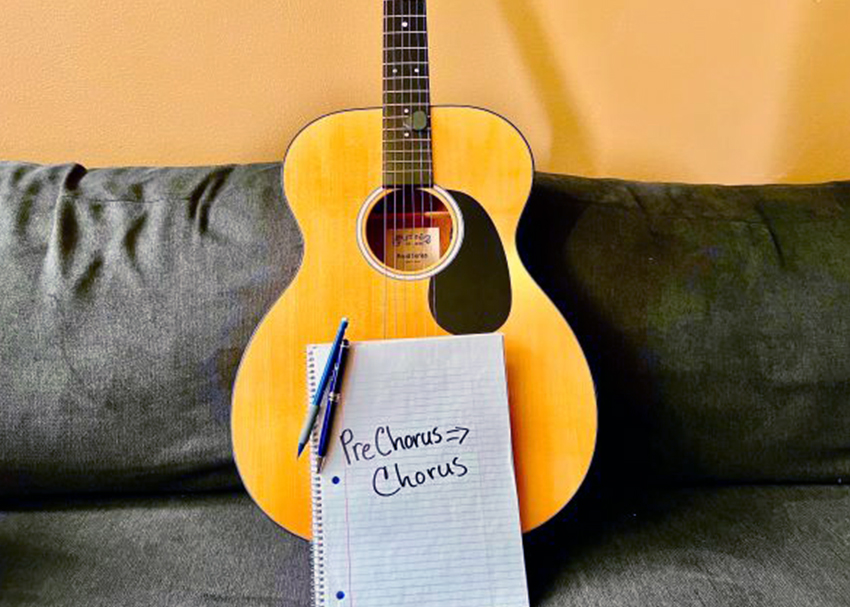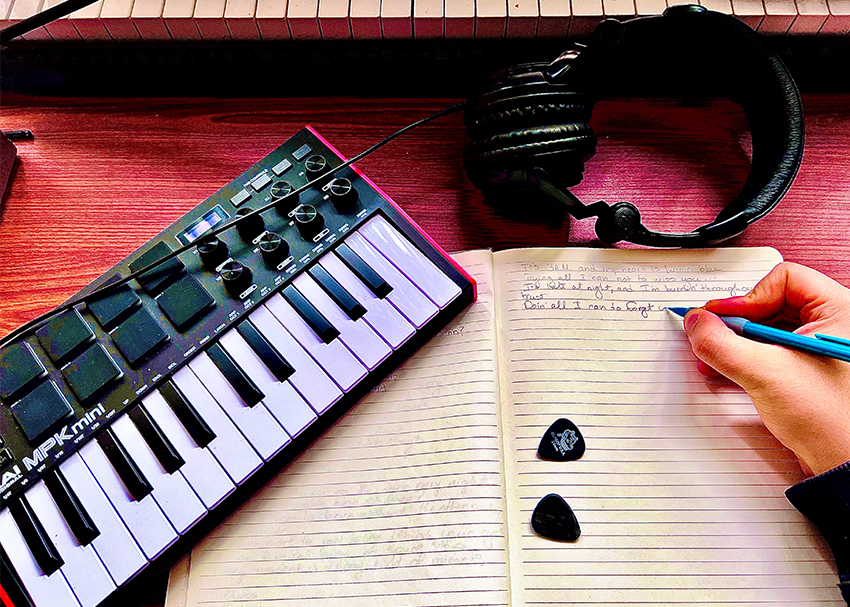In our previous post, we explored the inner workings of constructing verse lyrics and themes. But where do we go after we’ve nailed that first verse? Most often, we go to a pre-chorus and/or a chorus. Approaching writing these two sections can be overwhelming given the amount of possible options you have to work with. It can also be difficult because blurring the lines of what is “right” or “wrong” is not at all straightforward. Let’s use real-world song examples and an original song to explore how to write a chorus and pre-chorus!
Composing Pre-Chorus Harmony
The pre-chorus is a section that uses anticipation to transition you from the verse to your chorus. That anticipation can be created by the lyrics you use, but is most often created by the harmony. In addition to anticipation, we want to try to create a chord progression that begs for resolution into the chorus in any way shape or form. Let’s take a look at “These Days” by the Foo Fighters as an example:
The verse of this song alternates between variations of A major and D major. Going into the pre-chorus, we have:
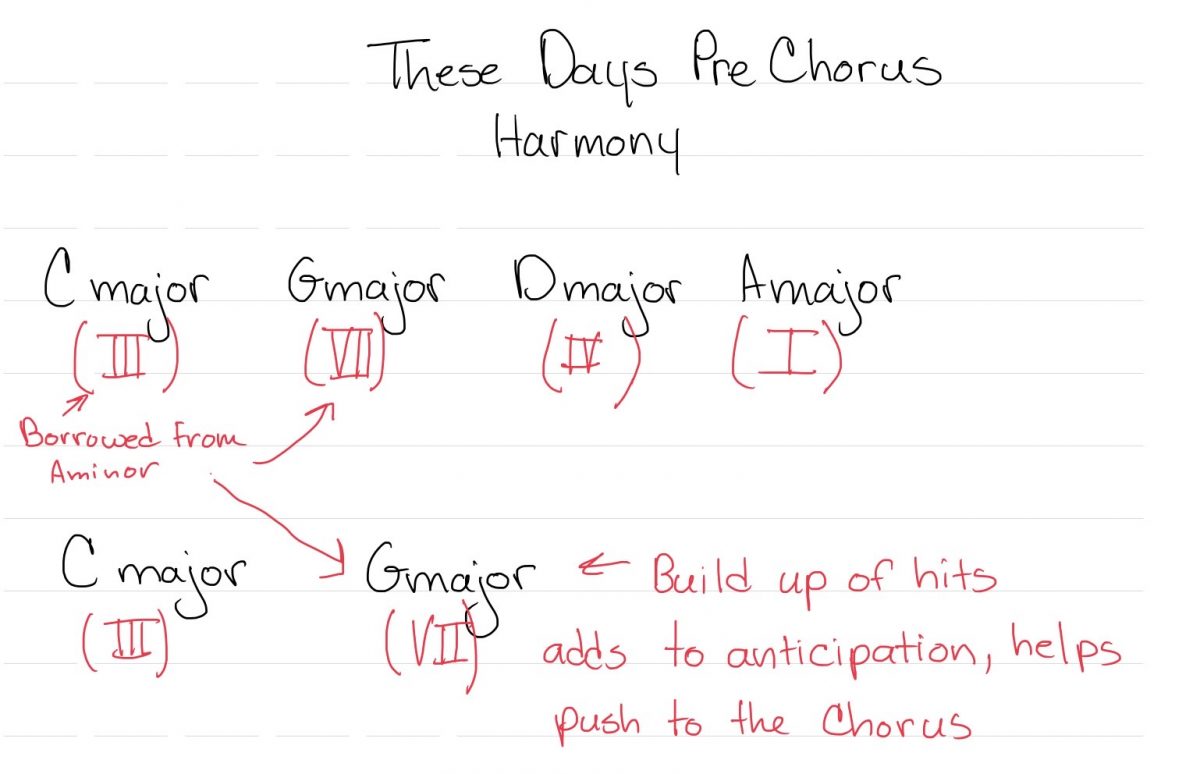
Two of the chords are borrowed from A minor, directing the song to a more intense feeling of seriousness and anticipation. As C major comes in, you start to feel the build up, and as the progression circles around, you start to feel a pull towards something that is going to erupt.
When G major comes around the second time, the song has a build up of hits both by the drums and the guitars. This gives G major more firepower to lead us into the next section. Because of the combination of harmony and dynamics, we erupt and resolve into the next section!
A Subtle Mood Swing
The idea here is that the pre-chorus should briefly shift the mood of the song in a way that is subtle but still felt. After that new mood is established, the anticipation should take over and lead us into the chorus. This is achieved by a change in the chord progression between the two sections. But the example from “These Days” is not the only approach. You may also consider going to the 4, the 5, or even the 6 chord here. These are also popular choices that will help you divert your verse to the next section of the song. Experiment, try them out, and see what you come up with!
Related: It’s Your First Verse: Make it Pop!
Learn how to write a first verse that sets the foundation for your entire song and hooks listeners right away | Read »
Writing Pre-Chorus Lyrics
The lyrics in this section should connect the themes from your verse to your chorus. In addition to this, the lyrics here act as a refrain in a way. The idea with this is that each time you return to this section, the melody and lyrics should repeat. So, how do we write lyrics to connect our themes?
Verse:
One of these days the ground will drop out from beneath your feet
One of these days your heart will stop and play its final beat
One of these days the clocks will stop and time won’t mean a thing
One of these days their bombs will drop and silence everything
The message to open the song is that nothing lasts forever, and one day, you will reach the end and none of it will matter. At least..that’s what we think right now.
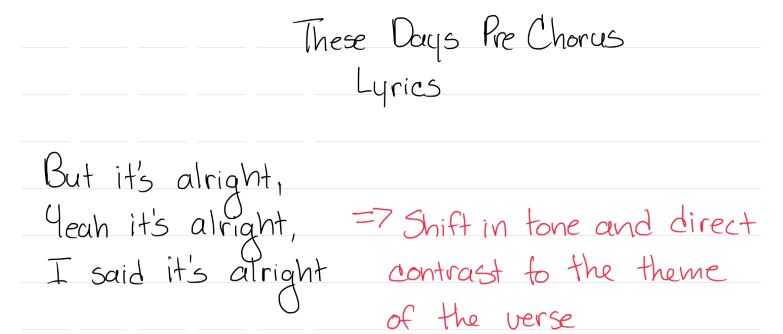
Here, we see a shift in mood. We go from the melancholy theme of the verse that borders on hopelessness, to saying that despite this, everything will be okay. The pre-chorus lyrics are evolving the thought process from an initial thought to a resolution of that thought. Everything will end and not mean a thing? That’s okay; it is what it is.
Theme Expansion
You start the song by introducing your theme in verse 1. Then, the pre-chorus will expand upon that theme, or question it – and we answer that question in the chorus. This is fundamentally how you want to connect these sections in order to create a thread through your song that can be followed by the listener.
Writing Chorus Lyrics
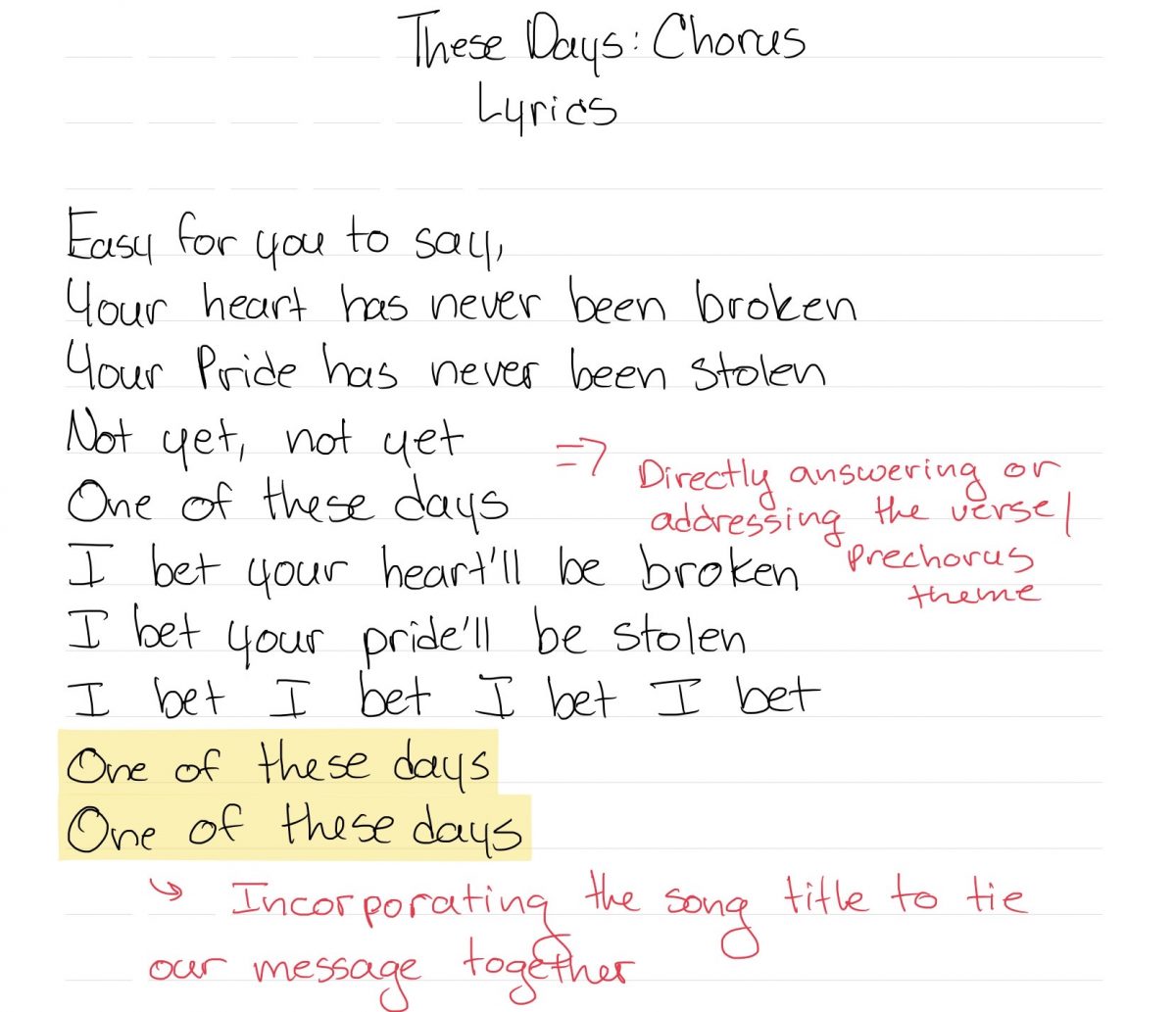
Continuing the analysis of going from the pre-chorus into the chorus, note that there is a sharp change in theme and perspective. The lyrics in this section are essentially an answer to what we are being told in the verse and pre-chorus. Basically, forget all of that. It’s easy for you (the person telling us things are ending) to say these things having never experienced hardship and bounced back from it to survive. This evolution continues into the chorus by saying that one day, these things will happen to you, and you will understand what it means to not to give up in the face of adversity.
Answer Questions With Your Chorus
The chorus is where we want everything to come together thematically. As mentioned before, the verse introduces the theme. The pre-chorus expands upon it, and/or questions that theme, and the chorus is the answer for it. Since we want the chorus to feel satisfying, we want to try to answer our themes as directly as possible. Doing so vaguely may result in an unsatisfying chorus.
So, when you write your chorus, think of ways to tie everything together. Inserting the title of your song is a great way to do this if you are having trouble. It is not always necessary, but it should directly address what it is you are writing about.
Composing Chorus Harmony
In “These Days,” the song is resolving to A major but two out of the four chords are borrowed from A minor. This gives the chorus a combination of serious and uplifting feelings. This mix of feelings is appropriate for this song’s meaning: even though the initial resolution to A major lifts us up, the lyrics in tandem with the harmony create a tone of seriousness.
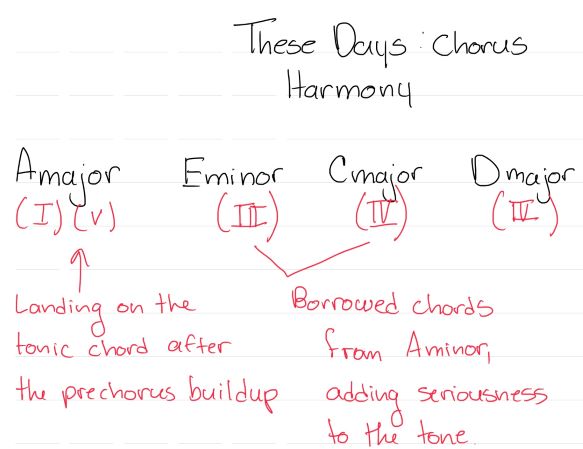
Keep the Chorus Fresh
It is important to note here, that the separation the pre-chorus creates between the verse and chorus allows this section to start on the tonic chord of the song and still feel fresh. It is completely acceptable to do this without sounding repetitive if you resolve the pre-chorus to the chorus effectively, and you add interesting build ups or dynamic changes to aid your harmonic idea.
Building on this point, it is worth noting that the resolution from a borrowed major chord in A minor to the tonic in A major, while not a typical cadence in popular or rock music, is still an impactful one. See, there is no black and white “right” way to handle that resolution into the chorus. Some ways are better than others, sure. For instance, a V-I perfect cadence has a more obvious feeling of resolution than the resolution in These Days. But as long as your progression creates anticipation, and resolves to the chorus, then you are handling this section effectively.
Alternate Resolution Ideas
Example: “Fall To Pieces” – Velvet Revolver – Resolves to the V chord in the pre-chorus, then back to the I chord to start the chorus.
Finally, we should note that the chorus progression itself is an expanded version of the verse. In the verse, we have variations of A and D. This chorus adds two borrowed chords from A minor (like in the pre-chorus) in between them to expand the harmony. In essence, it is completely okay to borrow chords from your verse or pre-chorus to fill out your chorus. You would just want to make sure you are adding dynamic and lyrical changes to these sections to make them feel fresh.
To tie these thoughts together, use this song as an example of how to get into the chorus harmony and how to expand it, but also know that you should experiment with chords in and out of the key to create something that sounds awesome to you. Expand on previous progressions, recycle chords, and use dynamics to make this section work.
Now that we have thoroughly discussed harmonic and lyrical approaches to both the chorus and pre-chorus, let’s put these tools to work in creating our own song!
Putting It All Together
For this example, we will use and expand on the original verse from the previous post on verse writing.
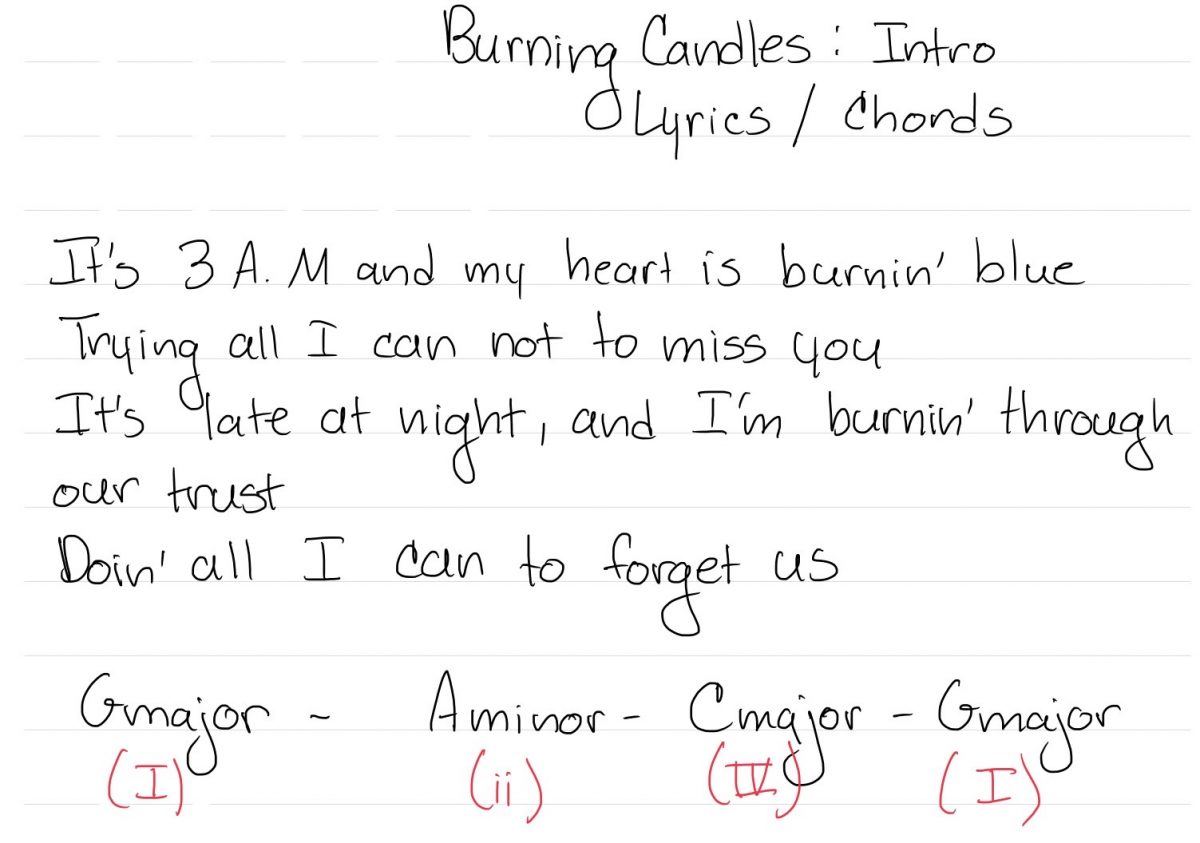
Here, the lyrics introduce the theme of the song and set the foundation, and the mood and feel are shaped through our harmony.
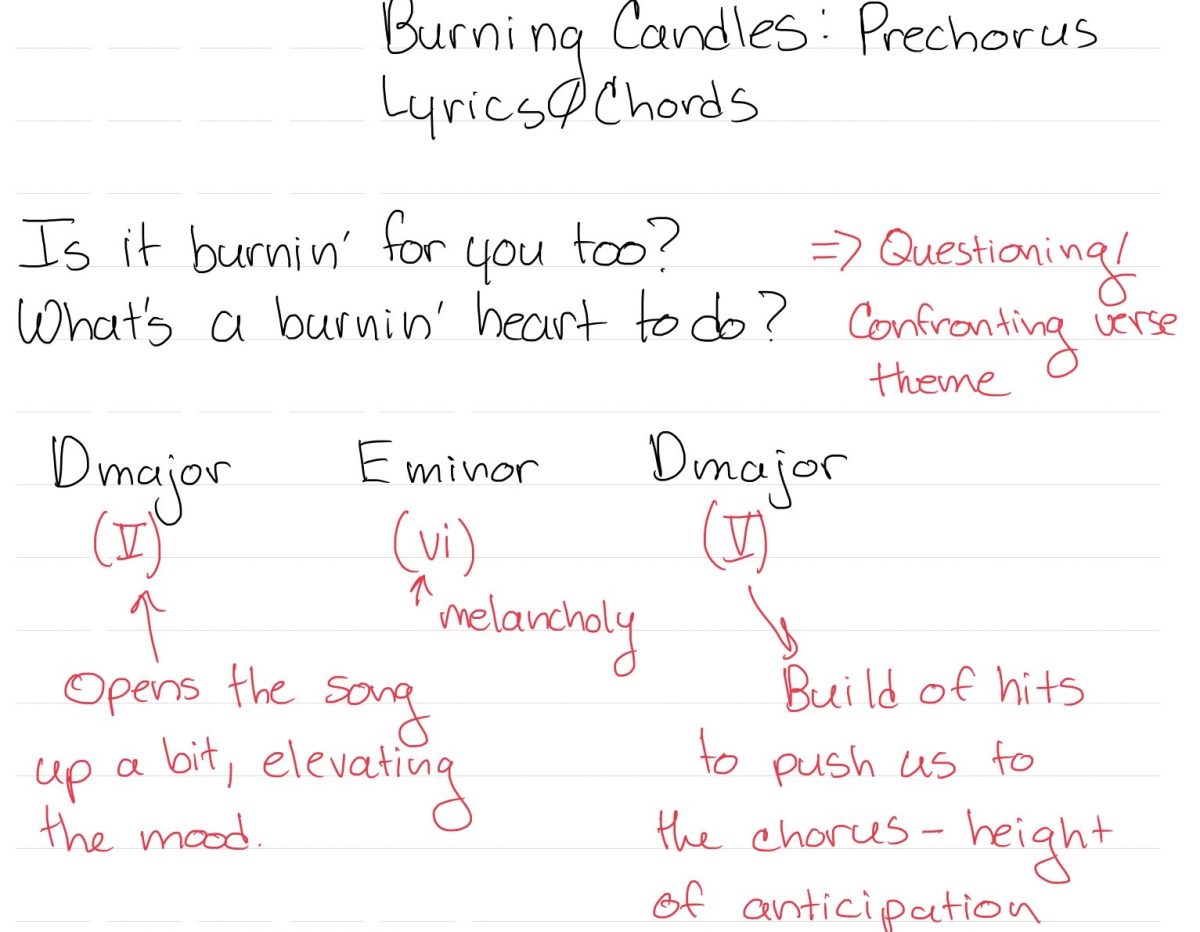
Here, we turn the question on the person we are expressing feelings for in the first verse. We ask if they feel what we feel. We also ask what is a heart that’s in pain supposed to do? Remember, changing perspectives or outright asking questions in the pre-chorus is great for anticipation. We also add a buildup on the last chord to jump into the next section of the song.
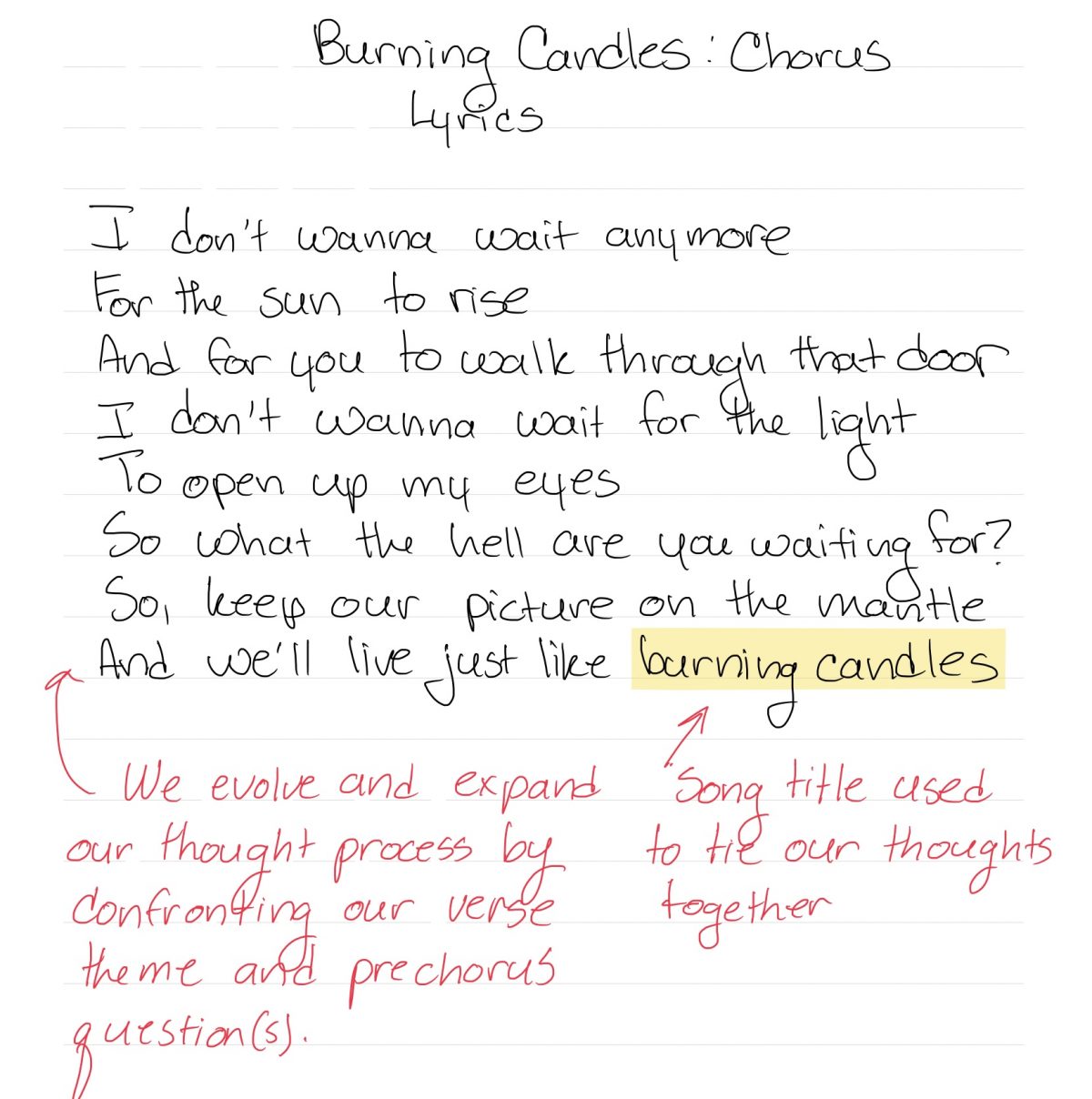
The chorus goes to the major IV chord which is a great option to open up the song in a satisfying way. We also combine chords from the pre-chorus and the verse to make this section feel familiar but also fresh – similar to our example “These Days” from earlier in the post.
Thematically we go from expressing anguish, to questioning that anguish, to fighting the anguish. This is ultimately the evolution we want to shoot for across these three sections. Lastly, we wrap up our chorus theme by using the song title. Doing this also puts a definite stopping point at the end of this section.
Take a listen to it all together:
Options, Not Rules
In conclusion, it’s important to look at the various approaches to writing these sections not as “rules,” but as “options.” Sure, some options definitely work better than others, but that’s why it’s important to try different things as you write. Use this post as an example of how to explore options. In addition to this, listening and studying the inner workings of songs will help expand your options.
In any case, I hope this post provided both knowledge and motivation for you to keep writing!

